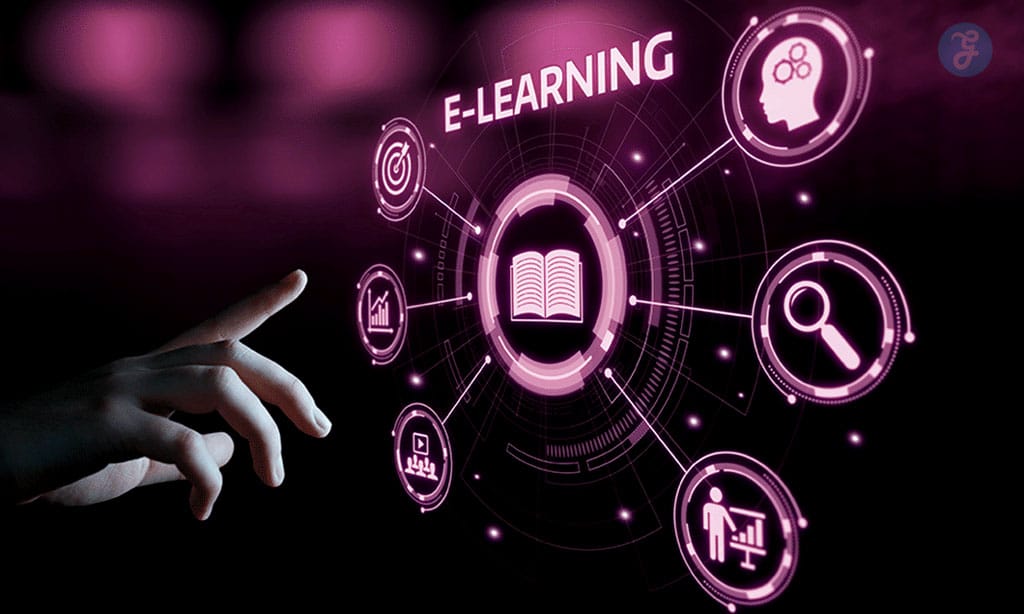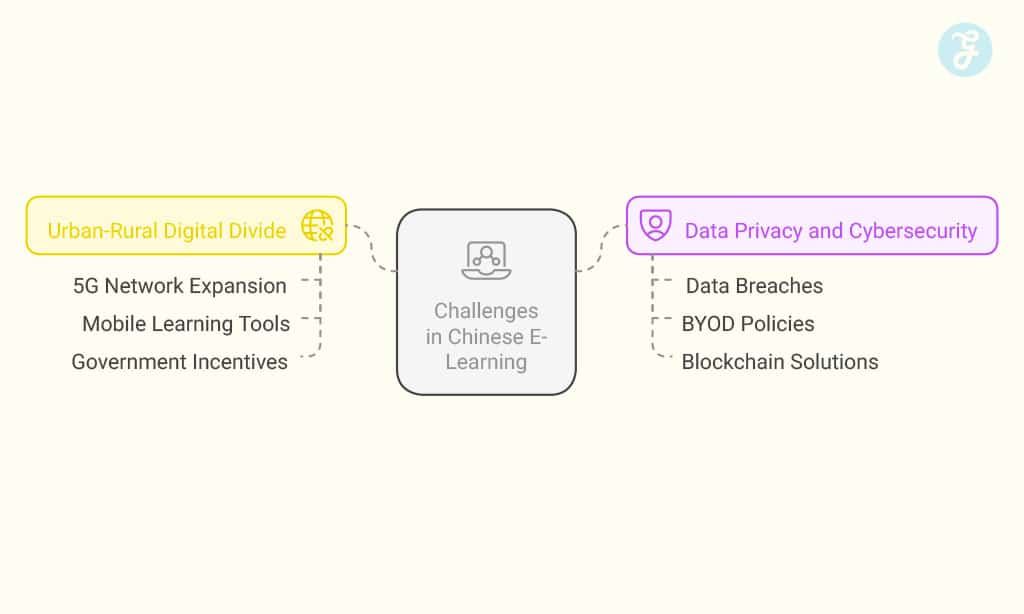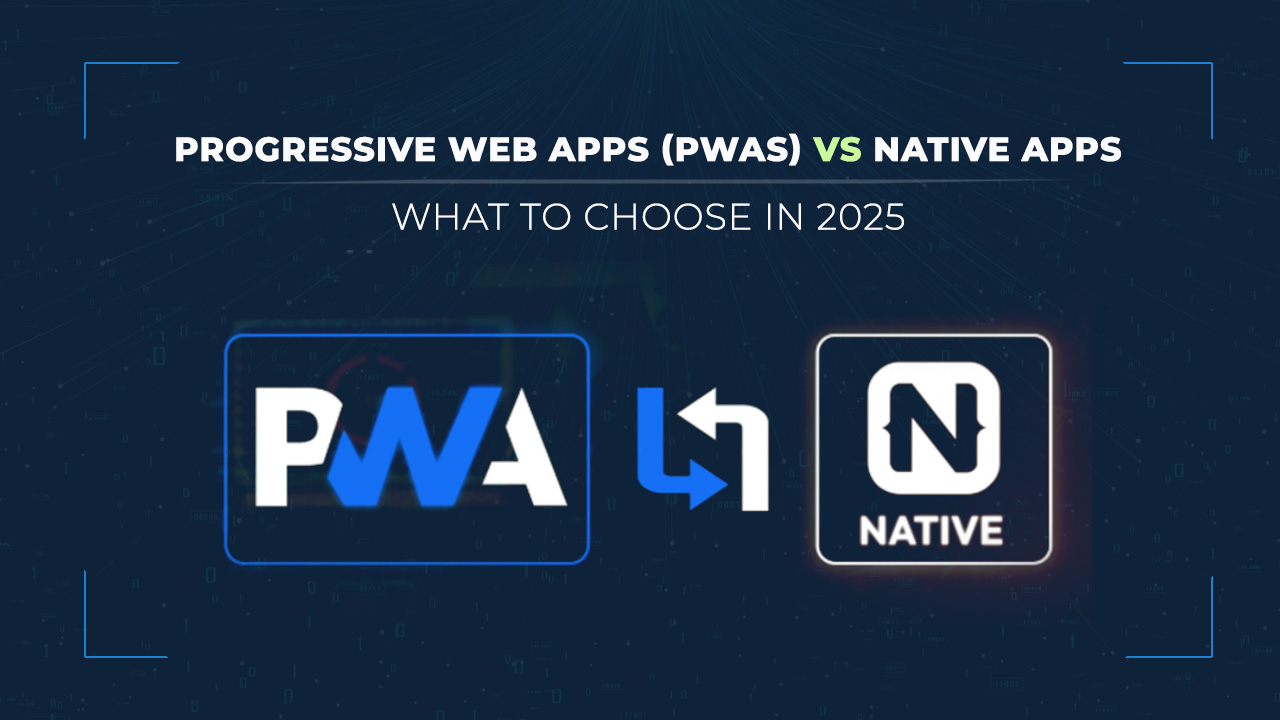China’s e-learning industry is reshaping education in a big way. By 2025, it’s set to hit massive growth, with advanced technologies like AI, AR/VR, and blockchain leading the charge.
Mobile learning has also made education more accessible than ever. This shift isn’t just about convenience—it’s changing how students learn and teachers teach.
With years of market research into online learning trends, we understand how this boom impacts educational institutions and student engagement. From personalized lessons to virtual classrooms, there’s much to explore in China’s digital transformation of education.
Keep reading—you’ll be amazed at what’s next!
Growth of China’s E-Learning Industry
China’s e-learning market is booming, with rapid expansion in both urban and rural areas. The increasing use of digital technology has made education more accessible for millions of users.
Market size and projected revenue in 2025
The e-learning industry in China is reaching new heights. With its rapid growth, the market is set to become a multi-billion-dollar powerhouse by 2025. Below is a succinct snapshot of the market size and projected revenue.
| Category | Details |
|---|---|
| Projected Market Size | US$40.43 billion (Online Learning Platforms market) |
| Growth Rate | 11.50% CAGR (2025–2033) |
| Internet Penetration Rate | 76.4% |
| Key Drivers | Increased adoption of digital tools, government support, and demand for personalized learning |
This booming sector reflects China’s commitment to reshaping education digitally.
Key drivers of growth in the Chinese e-learning sector
Rising internet access fuels e-learning in China. More people now use smartphones and digital platforms. This creates a bigger audience for online courses and mobile learning apps.
In 2023, the K-12 sector had 291 million students enrolled in digital education programs.
Government policies are another key factor. The “Double Reduction Policy” supports reducing academic pressure while boosting the quality of online teaching. Investments also improve digital infrastructure, making e-learning accessible nationwide.
New tech like AI drives personalized learning experiences. It helps tailor lessons to each student’s needs, boosting engagement and results. The language learning app market hit $478 million in value by 2023—showing strong demand for skill-building tools.
Emerging Technologies Shaping E-Learning in China
New technologies are changing how people learn in China. Tools like AI and AR make online education more engaging, smart, and personal.
Artificial Intelligence (AI) in personalized learning
AI improves learning by making it personal. Tools powered by artificial intelligence track how students perform, spot weak areas, and suggest materials to help. Intelligent tutoring systems (ITS) act like private tutors.
They give instant feedback and adjust lessons based on needs.
Teachers save time with AI as it handles tasks like class scheduling and grading assignments. This allows more focus on teaching methods and student interaction. Digital technology enhances user engagement through adaptive learning platforms, boosting results in online education in China.
Virtual and Augmented Reality for immersive education
Virtual reality (VR) and augmented reality (AR) create hands-on learning without leaving the classroom. Students can explore real-world tasks like surgical practice in a virtual environment.
These tools enhance collaboration during group projects, boosting teamwork skills.
China uses AR/VR to make online education engaging. It helps students interact with content in new ways, making lessons more exciting and memorable. This immersive learning style is becoming popular for subjects like science and vocational training.
Blockchain for secure certification and data management
Blockchain technology ensures safe and verified digital certifications. Over 60% of Chinese educational institutions now explore this system for tamper-proof diplomas. Students receive a secure digital wallet to store and share these credentials easily.
This method prevents fraud while simplifying verification for employers or schools. Decentralized systems keep data safe from breaches. Blockchain also supports lifelong learning by tracking skills and e-learning courses in one trusted place.
Mobile learning platforms for accessibility
Mobile applications make learning easy for millions in China. Smartphones and tablets help students study anytime, anywhere. Offline features allow people in rural areas to access educational content without the internet.
This creates a better learning environment for underserved groups.
These platforms support language apps, university courses, and vocational training. They boost digital literacy by making education available on affordable devices. Mobile learning tools also encourage collaborative learning through live streaming or virtual classrooms.
The Rise of AI-Generated Content in China’s Digital Media and its Influence on E-Learning
AI-generated content is reshaping how students learn in China. Advanced algorithms now create study materials, quizzes, and even interactive simulations. These tools save time for teachers and help personalize lessons for each student.
Educational robots powered by AI also assist with learning management, making e-learning more efficient.
Such technology supports platforms offering online education like language apps and vocational training courses. Content delivery networks ensure fast access to resources while AI improves user experience on mobile learning platforms.
This integration boosts accessibility and lifelong learning opportunities across the Chinese market.
Popular Learning Formats in China
Chinese learners enjoy many digital education tools that fit their busy lives. These formats help students improve skills, prepare for exams, and explore new subjects with ease.
Language learning applications
Language learning apps have reshaped education in China. The growing need for multilingual skills has boosted their popularity. These tools, including platforms like Babbel, offer quick lessons and practical exercises.
They help users master languages for studying abroad or expanding job opportunities.
Mobile learning apps are convenient and easy to use. Many provide audio clips, PDFs, and interactive quizzes to improve vocabulary and pronunciation. Features like AI-powered personalization tailor lessons to individual progress levels.
With the digital technology boom, these applications ensure accessible language training for millions of internet users across China’s e-learning market segments.
Virtual classrooms and live tutoring platforms
Virtual classrooms make learning flexible. Students access lessons on mobile learning platforms anytime, anywhere. These platforms support real-time video sessions, interactive tools, and digital whiteboards.
AI-powered tutors in live tutoring systems offer personalized help based on each student’s progress.
The demand for online education grows fast in China’s market. The after-school tutoring segment alone is expected to increase by $130.8 billion between 2025 and 2029. Many educational institutions now adopt O2O models that blend virtual lessons with offline guidance for better results.
Microlearning modules for skill development
Chinese companies embraced microlearning since 2015. By 2023, 95% of surveyed businesses knew about it, and 46.5% were very familiar with using these modules. They use short lessons to teach specific skills quickly.
This saves time and improves learning.
Mobile learning platforms make these bite-sized lessons easy to access anywhere. Workers use them for vocational training or mastering complex software. Companies focus on digital education to stay competitive in online learning markets like e-commerce and business-to-consumer (B2C) sectors.
The Role of Government Policies and Investments
Government programs are boosting digital learning systems and funding new technologies. These steps make online education more widespread and efficient for students across China.
Support for digital education infrastructure
China heavily invests in digital education infrastructure. The “Artificial Intelligence Empowering Education” program boosts teaching with smart tools. Schools use AI-powered learning devices to improve efficiency and access.
These investments help create online learning platforms, reaching more students across rural and urban areas.
Strategic partnerships also play a big role. Companies work with schools to develop mobile learning apps and blended learning systems. Government funding increases support for public educational institutions, vocational training programs, and higher education technology upgrades like the Smart Education of China (SEC) platform.
This focus strengthens lifelong learning opportunities nationwide.
Integration of e-learning in public education systems
E-learning is changing how public schools teach students. It makes learning easier and helps more people learn in new ways.
- The Chinese government invests a lot in digital education infrastructure. This supports online tools in classrooms across the country.
- The National K-12 Education Resource Network gives rural schools access to quality materials. It helps close the education gap between urban and rural areas.
- Smart Education of China (SEC) platform offers advanced tech for schools. It provides teachers with teaching aids and students with better resources.
- Government policies push schools to adopt online learning platforms. These include mobile learning options for more accessibility.
- The Double Reduction policy reshapes after-school tutoring rules. Schools now focus on improving digital lessons within public systems.
- Many educational institutions use virtual classrooms for higher education classes or university courses. This reaches students even in remote places.
- Lifelong learning programs are added to help adults gain skills through vocational training or vocational courses. These make it easier to stay competitive at work.
- Secure certifications use blockchain technology, ensuring safe data management in e-learning records for all levels of schooling.
- Teachers use artificial intelligence (AI) tools to personalize content for each student’s needs, making studying smarter and faster through smart technologies.
- Subsidies from local governments support joint ventures between educational companies and schools, ensuring access to modern technological advancements at lower costs for everyone involved!
Challenges in the Chinese E-Learning Landscape
Urban areas enjoy advanced digital tools, but rural regions often lag behind. Protecting student data and online safety also remains a pressing issue.
Bridging the urban-rural digital divide
Expanding 5G networks brings hope to rural areas. Faster internet connects villages to online education and e-learning platforms. This helps kids in remote places access the same resources as city students.
Mobile learning tools make lessons easy to reach, even on basic smartphones.
The government offers incentives for college graduates to work in rural areas. These graduates boost local governance and build digital skills among communities. Developing a rural digital talent ecosystem reduces gaps between urban and rural education levels.
Data privacy and cybersecurity concerns
Data breaches remain a big issue for online education platforms. Schools and universities struggle to vet new tools quickly, leaving gaps in security. Bring Your Own Device (BYOD) policies add more risk since personal devices often lack strong protection.
Ongoing training is a must for students and staff. They need to spot phishing scams or weak passwords that cybercriminals exploit. Blockchain can help secure data, but many institutions still don’t use it widely.
Stronger digital infrastructure could reduce these risks while supporting safe lifelong learning programs on e-learning platforms.
The Impact of E-Learning on Education Outcomes
E-learning opens doors for students who might otherwise struggle to access quality education. With advanced technology, it makes learning more flexible and engaging for different needs.
Increased accessibility for underserved communities
The CN2 network boosts digital access in rural China. It brings online education tools to remote areas, supporting vocational training and lifelong learning. Mobile learning platforms help students connect with teachers using real-time interactive sessions.
More children in underserved communities now join virtual classrooms or explore study abroad opportunities through mobile technology. Digital infrastructure ensures smoother communication for these students, closing the urban-rural gap in education resources.
Enhanced teacher-student collaboration through technology
Digital technology connects teachers and students easily. Online education platforms provide tools for live tutoring, interactive lessons, and shared resources. Real-time feedback through innovative assessments improves communication during lessons.
Mobile learning apps help teachers track progress while giving students more control over their pace.
Virtual classrooms encourage teamwork with group projects and discussions. Artificial intelligence (AI) personalizes tasks based on student needs, making learning smarter and faster.
These tools reduce teacher workload while boosting student success in both public schools and higher education settings.
Takeaways
China’s e-learning industry is revolutionizing education. It integrates technology, policy, and innovation to create transformative learning methods.
Dr. Mei Zhang, an authority in educational technology, has dedicated over 20 years to studying online learning. With a Ph.D. from Beijing University, she has contributed significantly to projects shaping digital education policies in China.
Her work focuses on combining tech with teaching to enhance accessibility and tools for students worldwide.
According to Dr. Zhang, AI-driven platforms emerge as the most impactful. They personalize lessons for each learner using data analysis—providing immediate feedback that accelerates student progress.
Tools like AR/VR offer hands-on learning experiences, while blockchain ensures secure records of achievements.
Dr. Zhang emphasizes potential challenges such as privacy concerns or disparities in access between urban and rural areas but also commends stringent government policies aimed at maintaining safety and equity.
To optimize the daily use of these systems, she advises ensuring devices are kept updated and promoting active engagement rather than passive consumption.
Overall, China’s e-learning growth delivers significant advantages: personalized learning approaches, immediate support systems, and immersive educational environments. However, challenges persist, including regional fairness gaps and technological limitations in some schools when compared globally.
Yet, for those prepared, it presents remarkable opportunities as new approaches reshape international perspectives, offering long-term benefits and consistent advancements with forward momentum.
This evolution opens up vast possibilities, driving lasting innovations and inspiring continued achievements in education, creating impactful transformations for generations to come.
FAQs on How China’s E-Learning Industry is Transforming Education
1. How is China’s e-learning industry growing in 2025?
China’s e-learning industry is expanding with advancements in digital technology, online education platforms, and smart education systems like the SEC platform. The market forecast shows strong growth driven by vocational training, higher education, and lifelong learning.
2. What role does artificial intelligence play in China’s digital education?
Artificial intelligence helps improve online learning platforms by personalizing courses, enhancing mobile learning experiences, and supporting educational institutions with smarter tools for teaching and management.
3. How has the double reduction policy impacted China’s e-learning sector?
The double reduction policy shifted focus from traditional tutoring to innovative solutions like digital infrastructure development, university courses offered online, and adult education programs powered by technological advancements.
4. What makes China’s e-learning market competitive?
Porter’s Five Forces analysis highlights factors such as venture capital investments in educational technology companies, business strategies tied to exchange rates stability, and a competitive advantage gained through advanced computing tools.
5. Can lifelong learning benefit from these changes?
Yes! Lifelong learners can access vocational training programs or postgraduate studies through flexible options like mobile learning apps or YouTube videos designed for diverse audiences.










































